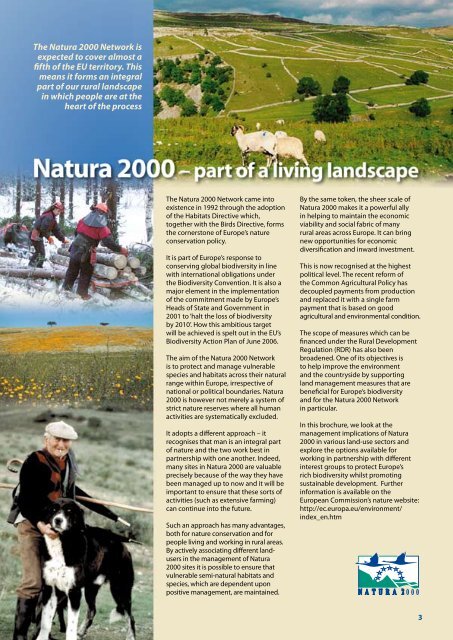00 800 6 7 8 9 10 11 - European Commission - Europa
00 800 6 7 8 9 10 11 - European Commission - Europa
00 800 6 7 8 9 10 11 - European Commission - Europa
Create successful ePaper yourself
Turn your PDF publications into a flip-book with our unique Google optimized e-Paper software.
The Natura 2<strong>00</strong>0 Network is<br />
expected to cover almost a<br />
fifth of the EU territory. This<br />
means it forms an integral<br />
part of our rural landscape<br />
in which people are at the<br />
heart of the process<br />
The Natura 2<strong>00</strong>0 Network came into<br />
existence in 1992 through the adoption<br />
of the Habitats Directive which,<br />
together with the Birds Directive, forms<br />
the cornerstone of Europe’s nature<br />
conservation policy.<br />
It is part of Europe’s response to<br />
conserving global biodiversity in line<br />
with international obligations under<br />
the Biodiversity Convention. It is also a<br />
major element in the implementation<br />
of the commitment made by Europe’s<br />
Heads of State and Government in<br />
2<strong>00</strong>1 to ‘halt the loss of biodiversity<br />
by 20<strong>10</strong>’. How this ambitious target<br />
will be achieved is spelt out in the EU’s<br />
Biodiversity Action Plan of June 2<strong>00</strong>6.<br />
The aim of the Natura 2<strong>00</strong>0 Network<br />
is to protect and manage vulnerable<br />
species and habitats across their natural<br />
range within Europe, irrespective of<br />
national or political boundaries. Natura<br />
2<strong>00</strong>0 is however not merely a system of<br />
strict nature reserves where all human<br />
activities are systematically excluded.<br />
It adopts a different approach – it<br />
recognises that man is an integral part<br />
of nature and the two work best in<br />
partnership with one another. Indeed,<br />
many sites in Natura 2<strong>00</strong>0 are valuable<br />
precisely because of the way they have<br />
been managed up to now and it will be<br />
important to ensure that these sorts of<br />
activities (such as extensive farming)<br />
can continue into the future.<br />
Such an approach has many advantages,<br />
both for nature conservation and for<br />
people living and working in rural areas.<br />
By actively associating different landusers<br />
in the management of Natura<br />
2<strong>00</strong>0 sites it is possible to ensure that<br />
vulnerable semi-natural habitats and<br />
species, which are dependent upon<br />
positive management, are maintained.<br />
By the same token, the sheer scale of<br />
Natura 2<strong>00</strong>0 makes it a powerful ally<br />
in helping to maintain the economic<br />
viability and social fabric of many<br />
rural areas across Europe. It can bring<br />
new opportunities for economic<br />
diversification and inward investment.<br />
This is now recognised at the highest<br />
political level. The recent reform of<br />
the Common Agricultural Policy has<br />
decoupled payments from production<br />
and replaced it with a single farm<br />
payment that is based on good<br />
agricultural and environmental condition.<br />
The scope of measures which can be<br />
financed under the Rural Development<br />
Regulation (RDR) has also been<br />
broadened. One of its objectives is<br />
to help improve the environment<br />
and the countryside by supporting<br />
land management measures that are<br />
beneficial for Europe’s biodiversity<br />
and for the Natura 2<strong>00</strong>0 Network<br />
in particular.<br />
In this brochure, we look at the<br />
management implications of Natura<br />
2<strong>00</strong>0 in various land-use sectors and<br />
explore the options available for<br />
working in partnership with different<br />
interest groups to protect Europe’s<br />
rich biodiversity whilst promoting<br />
sustainable development. Further<br />
information is available on the<br />
<strong>European</strong> <strong>Commission</strong>’s nature website:<br />
http://ec.europa.eu/environment/<br />
index_en.htm<br />
3

















